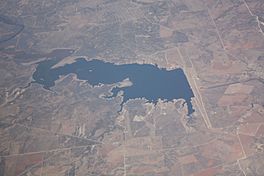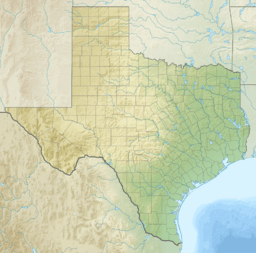E.V. Spence Reservoir facts for kids
Quick facts for kids E.V. Spence Reservoir |
|
|---|---|

E.V. Spence Reservoir, facing northeast, January 2009
|
|
| Location | Coke County, near Robert Lee, Texas |
| Coordinates | 31°54′30″N 100°32′07″W / 31.90833°N 100.53528°W |
| Primary inflows | Colorado River |
| Primary outflows | Colorado River |
| Basin countries | United States |
| Surface area | 14,950 acres (6,050 ha) |
| Max. depth | 108 ft (33 m) |
| Water volume | 488,750 acre⋅ft (602,860,000 m3) |
| Surface elevation | 1,898 ft (579 m) |
E.V. Spence Reservoir, also known as Lake E.V. Spence, is a large man-made lake in Texas. It is located west of the town of Robert Lee. The lake was created in 1969 when the Robert Lee Dam was built.
The main reason for building E.V. Spence Reservoir was to provide a steady water supply for Robert Lee and other nearby towns in Coke County. The lake is also a popular spot for fun activities. People enjoy fishing, boating, and swimming here. The Colorado River Municipal Water District helps manage the Robert Lee Dam.
Contents
Fish in E.V. Spence Reservoir
This lake is a great place for fishing! Many different kinds of fish live in E.V. Spence Reservoir. These fish were put into the lake to make fishing even better for everyone.
What Fish Can You Catch?
Some of the fish you might find in the lake include:
Drought and Water Levels
E.V. Spence Reservoir has faced some tough times due to very dry weather. A drought means there is not enough rain for a long time. This can cause water levels in lakes to drop very low.
When Water Levels Dropped Low
In July 2011, the lake's water level was extremely low. It was less than 1% full, almost dry. This happened because of a severe drought and very hot summer temperatures. Because of this, the water district had to stop taking water from the lake for towns like Midland, Texas. If the lake were to completely dry up, water would need to be brought in by trucks to supply Robert Lee.
How the Lake Recovered
By September 2012, the lake reached its lowest point ever. It was less than 0.2% full. This meant there was very little water left. However, after a big rainstorm in September 2012, the lake started to recover quickly. Its capacity jumped to almost 6%.
The lake's water levels have slowly been getting better since then.
- In May 2014, it was 2% full.
- By May 2015, it was 4.4% full.
- As of August 2, 2019, the lake was at 30.5% capacity.



